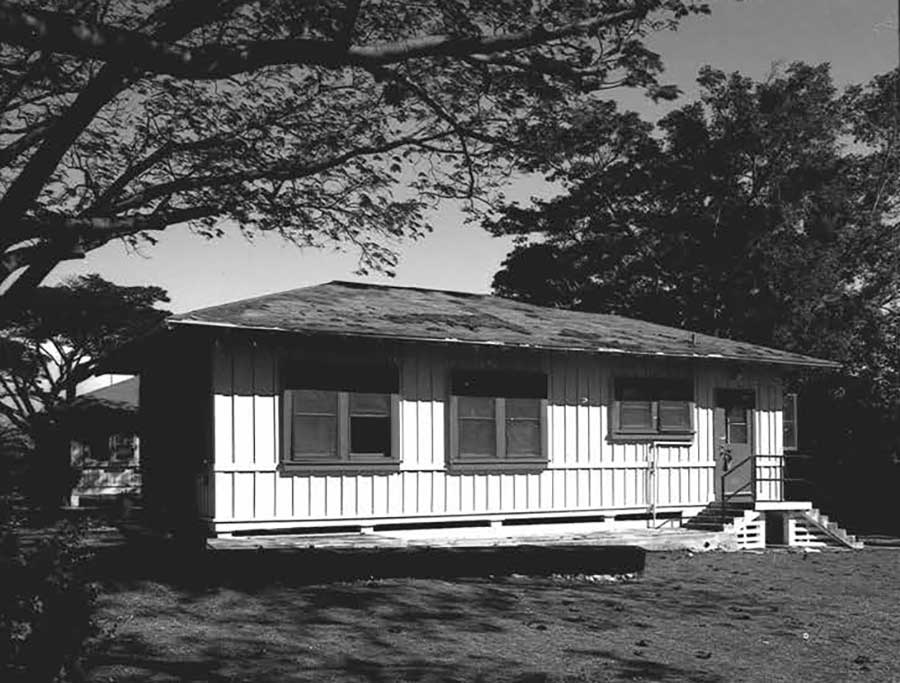CPO Bungalow on Ford Island was listed as a “Most Endangered” Historic Site in 2005
In July, the National Park Service (NPS) released its report examining the facts and circumstances surrounding the demolition of a historic bungalow at World War II Valor in the Pacific National Monument that was present during the attack on Pearl Harbor in 1941. The original intent of the National Park Service was to rehabilitate the aging bungalow and preserve its historic setting. However, the park failed to complete required consultation with proper authorities and the bungalow was leveled to its foundation in late 2015 and replaced with a similar building earlier this year.
In 2012, the National Park Service completed an environmental assessment to preserve, rehabilitate and restore the six Chief Petty Officer (CPO) bungalows on Ford Island for use by visitors and park administration. Subsequently, the National Park Service executed a programmatic agreement with the Hawaiʻi State Historic Preservation Division and the Advisory Council on Historic Preservation regarding the preservation of the historic CPO Bungalows. The park received funding in 2015 and began work in November 2015 on CPO Bungalow #28.
While the intent was to rehabilitate the bungalow and preserve its historic setting, in actuality, the park’s work involved demolishing the historic building and constructing a new building on top of the original foundation. Some of the historic fabric from the original building such as the windows and doors were salvaged, but not reused in the new building. The demolition and construction work has resulted in an adverse effect on CPO Bungalow #28 which was a contributing resource in the United States Naval Base Pearl Harbor National Historic Landmark.
The report identified a lack of understanding at the park of cultural resource preservation laws and responsibilities along with staff turnover as primary factors contributing to this failure. The report calls for the implementation of several corrective actions to improve the park’s and region’s ability to carry out its cultural resource stewardship responsibilities and prevent a similar situation from occurring in the future.
“This was an unfortunate incident that happened due to multiple factors and we deeply regret this,” said National Park Service Pacific West Regional Director Laura Joss. “The National Park Service takes its responsibility to protect our nation’s heritage very seriously, and moving forward, we will do everything necessary to ensure that we fulfill that duty. We intend to use the lessons we have learned at World War II Valor in the Pacific National Monument to improve our cultural resource compliance processes throughout the region.”
In June 2016, Joss convened a team to examine what led to the bungalow’s demolition, including identifying what went wrong and providing recommendations to prevent similar mistakes from occurring in the future. The team consisted of national and regional cultural resource preservation subject matter experts. The team established a chronology of events, conducted interviews with key staff, and collected and analyzed data and key project documentation.
On July 25, 2016, the team finalized its findings and recommendations and presented the report to Joss. The report finds that the NPS did not consult adequately with the State Historic Preservation Division (SHPD) and Advisory Council on Historic Preservation (ACHP) prior to dismantling CPO Bungalow #28. Many factors contributed to this outcome including a lack of understanding at the park of cultural resource laws and responsibilities, inadequate training for the park’s cultural resource compliance coordinator who was responsible for ensuring that the project adhered to cultural resource preservation law, turnover of key park staff members, and insufficient staffing at the park and in the regional office to provide effective oversight.
Historic Hawai‘i Foundation included the CPO Housing on Ford Island as one of the Most Endangered Historic Places in Hawai‘i in 2005. When the neighborhood was included in the designation of the World War II Valor in the Pacific National Monument in 2008, and stewardship for the property was transferred from the Navy to the NPS, the status was updated to indicate that preservation was pending and the threat was abated.
Historic Hawai‘i Foundation also signed the 2012 Programmatic Agreement that was to govern the management and preservation of the site as a concurring party. HHF will participate in the follow-up consultation to assess the effect and develop a response.
The NPS report includes recommendations to address the factors that led to the bungalow’s demolition. Among the immediate recommendations in the report are reinitiating consultation between the park superintendent and the SHPD, ACHP, and other parties to identify process deficiencies (such as departures of key personnel) and to avoid further potential adverse effects from any future work associated with the other five bungalows. In addition, the park’s cultural resource compliance coordinator will attend extensive training and receive mentoring in cultural resource law, and all cultural resource preservation work for the park will be reviewed and approved by the appropriate regional staff. All other park staff involved with cultural resource preservation work will also receive professional training. Furthermore, all new park superintendents within the region shall receive cultural resource compliance training within a year of their new assignment, and the region will review and approve all relevant projects until that training occurs.


